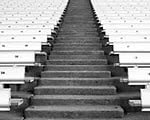
Part of becoming a SPARTA athlete involves giving up some old bad habits. Athletes usually understand very quickly why we tell them to stop doing any long slow distance training. They understand that teaching your fast twitch muscle fibers to act like slow twitch fibers is not going to help. Athletes say, “Got it, no more long distance running . . . but doing stadiums is OK right?” The tradition of running up and down stadium stairs for aerobic conditioning is a time-honored tradition in many sports.
Aside from just being distance running in disguise, there are many other reasons why running stadiums is detrimental for any athlete playing a sport where speed is important. The first involves range of motion. Muscles only get stronger in the range of motion that you consistently train them to operate. Research out of the Human Performance Laboratory at The University of Calgary showed a large discrepancy between the strengths of the quadriceps (thigh) muscle in cyclists, speed skaters and runners. The skaters’ and cyclists’—who spend most of their time in significant trunk flexion (bent over at the waist)— quadriceps were much stronger at shorter muscle lengths, while the runners’ quads were stronger at longer lengths, due to the more full range of motion in their sport. Now, if you imagine yourself running stadiums, your body stays bent at the waist while ascending, maintaining a short range of motion in your major leg muscles. In sports where full sprinting or maximal jumping is necessary, this limited hip range and strength will impair your performance and leave you more susceptible to injury.
The second thing to consider about stadiums is the surface you are running on. The days of old wooden bleachers are over, stadiums these days are made of metal and concrete. The surface that you run on can have a profound effect on the health of your joints. Research done in The department of Exercise and Sport Science at the University of Exeter in the UK, showed that running on traditional asphalt (as compared with rubber sport surfaces and modified rubber asphalt) created marked differences in joint angles and joint angular velocity, suggesting that harder running surfaces change the way your body absorbs impact. Repeated running on hard surfaces can drastically alter your stride and lead to overuse injuries.
Sir Isaac Newton and his universal law of gravity give us the last reason to avoid stadium training. We all know that what goes up must come down, so after you run all the way up that stadium you have to come all the way down. Research from The School of Human Kinetics at the University of Ottowa showed that descending stairs, even at slow speeds, places significantly more stress on lower extremity joints (especially the knee) and the muscles that control those joints. Repeated stress is the best was to develop an overuse injury.
So what can you do instead of stairs? Try strides: run at just below sprinting speed for 100 yards, and repeat that 10 times with 1 minute of rest between reps. The speed will insure that you use a full range of motion. Run on grass or field turf to reduce the impact on your joints. You’ll get the conditioning effect you’re looking for, and ensure that it won’t hinder your speed performance.